Making jams from fruits has been a longstanding tradition that offers many benefits. Not only does it allow us to preserve the flavors of our favorite fruits, but it also provides a sense of satisfaction and creativity. Homemade fruit jams are a delicious way to enjoy the abundance of seasonal fruits and add a touch of sweetness to our everyday meals. Let’s explore the reasons why we make jams from fruits and discover the joy of this sweet tradition.
Key Takeaways:
- Preserving the flavors of favorite fruits
- Incorporating creativity and satisfaction
- Enjoying the abundance of seasonal fruits
- Adding sweetness to everyday meals
- Exploring the joy of jam-making tradition
The History of Jam-Making
The art of jam-making has a rich and storied history that spans centuries. Over time, different fruit preservation methods have evolved, leading to the delicious fruit jam recipes that we enjoy today. Let’s take a step back in time and explore the fascinating journey of jam-making.
In the early days, people used honey to create fruit preserves. The fruit would be mixed with honey and left to dry in the sun, resulting in a sweet and preserved treat.
As sugar became more affordable in the 19th century, jams started to become more accessible to a wider population. Sugar not only added sweetness but acted as a preservative, allowing jams to be stored for extended periods.
Today, we have a wide variety of fruit jam recipes and methods to choose from. The fruit jam making process can range from slow cooking the fruit to using commercial pectin for a perfect set.
Understanding the evolution of fruit preservation methods and the techniques used in jam-making allows us to appreciate the rich history and diversity of this culinary tradition.
The Journey of Jam-Making
Let’s take a closer look at the journey of jam-making through the centuries:
| Time Period | Fruit Preservation Methods | Notable Developments |
|---|---|---|
| Ancient Times | Drying fruit with honey | – |
| 19th Century | Using sugar as a preservative | Accessibility of jams to the masses |
| Modern Era | Various fruit jam recipes and techniques | Diversity in flavors and methods |
As the demand for jams grew, so did the variety of fruit preservation methods and recipes. From classic strawberry jam to exotic combinations like mango and ginger, there is a fruit jam recipe to suit every taste. Whether you prefer traditional slow-cooking or using commercial pectin for a quick and reliable set, the possibilities are endless.
“The art of jam-making is a testament to our love for preserving the flavors of fresh fruits and cherishing the joy they bring to our tables.” – Anonymous
Stay tuned for the next section as we explore the role of ingredients in jam-making and how they contribute to the delicious flavors we enjoy in every jar.
The Role of Ingredients in Jam-Making
When it comes to making delicious jams, the choice of ingredients plays a crucial role in determining the flavor and texture of the final product. Different fruits and additional flavorings contribute to the unique taste and mouthfeel of each jam.
Natural Thickeners: Pectin-rich Fruits
One key ingredient in jam-making is pectin, a natural thickening agent found in certain fruits. Apples, quinces, and citrus peels are excellent sources of pectin. These fruits are known for their natural ability to help jams set properly, giving them a desirable consistency.
Meeting Pectin Requirements
However, not all fruits are naturally high in pectin. Fruits like strawberries and blueberries have lower pectin levels and may require additional measures to achieve the desired consistency. To address this, commercial pectin can be added to increase the pectin content. Alternatively, high-pectin fruits can be combined with low-pectin fruits to achieve the desired set.
Sugar: More Than Just Sweetness
While sugar adds sweetness to jams, it also serves other important functions. It acts as a preservative, helping to inhibit the growth of harmful bacteria and prolonging the shelf life of the jam. Additionally, sugar aids in the gel formation process, contributing to the texture and structure of the jam.
Exploring Flavor Possibilities
One of the joys of making homemade jams is the ability to experiment with different flavor combinations. By combining various fruits and adding spices or nuts, you can create a wide range of delightful fruit jam flavors. Whether it’s a classic strawberry-rhubarb jam or a unique blend of apricot and cardamom, your creativity knows no bounds.
“Choosing the right combination of ingredients is like composing a symphony of flavors, resulting in a harmonious and mouthwatering jam.” – Me
Embrace your culinary creativity and explore the endless possibilities of fruit jam flavors.
| Fruit Combinations | Popular Flavor Profile |
|---|---|
| Strawberries + Rhubarb | Tangy and Sweet |
| Blueberries + Lemon | Bright and Refreshing |
| Peaches + Ginger | Spicy and Fruity |
With the right combination of ingredients, you can create an array of mouthwatering fruit jams that will elevate your breakfast toast, enhance your dessert creations, or add a burst of flavor to a cheese platter. Get adventurous and let your taste buds guide you!
The Science Behind Jam-Making
Jam-making is not only a culinary art but also a scientific process. The combination of ingredients and their interactions create the delicious and satisfying texture of jams. Understanding the science behind jam-making allows us to appreciate the intricate balance and health benefits of this sweet creation.
Pectin: The Gel Network
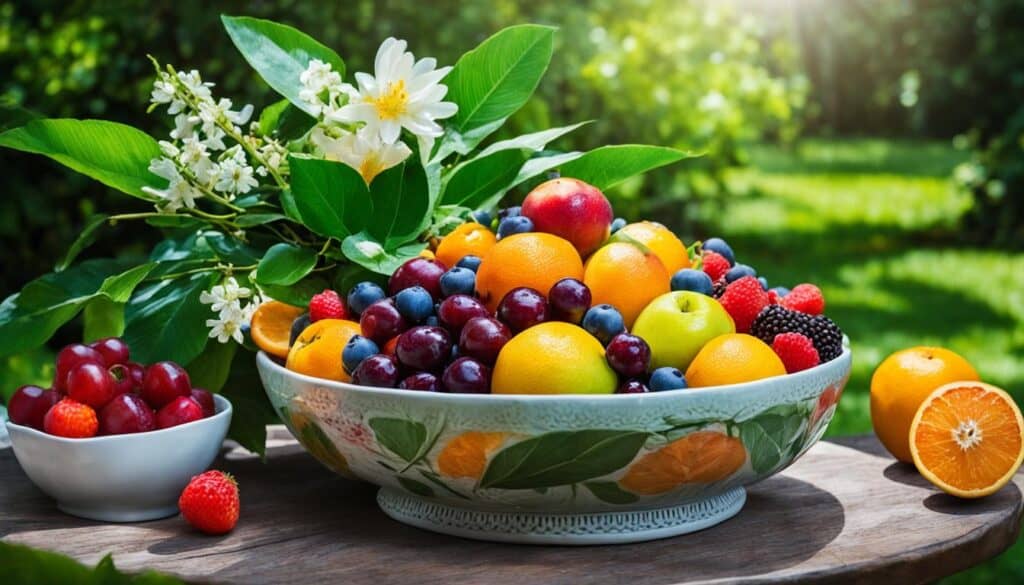
At the heart of every jam is pectin, a natural substance found in fruits that acts as a thickening agent. Pectin forms a gel network that traps the sugary liquid and cradles the suspended pieces of fruit, giving jams their characteristic texture. Different fruits have varying levels of naturally occurring pectin, which affects the jam’s ability to set.
The Role of Acid
“The addition of acid is crucial in jam-making. Acid, whether naturally present in fruits or from sources like lemon juice, helps reduce the negative electrical charge on the pectin branches. This reduction allows the pectin molecules to bond and form a strong gel.”
The acid in jams not only aids in gel formation but also contributes to flavor development. It gives brightness and balance to the overall taste and enhances the natural fruit flavors.
The Preservative Power of Sugar
Sugar plays multiple roles in jam-making. Besides adding sweetness, it acts as a preservative that inhibits the growth of microorganisms. The high sugar content creates an environment where bacteria, yeast, and molds cannot thrive, extending the shelf life of the jam.
Health Benefits of Fruit Jams
While jams should be enjoyed in moderation due to their calorie content, they provide health benefits derived from the fruits used in their creation. Fruits contain essential vitamins, minerals, and antioxidants that can be preserved and enjoyed in jams. These nutrients contribute to overall well-being and can be a convenient way to incorporate fruit into a balanced diet.
The Recipe for Perfect Jam
Making the perfect jam requires the right balance of ingredients and a proper cooking technique. Most jam recipes recommend a 1:1 ratio of fruit to sugar, although this can be adjusted to personal preference. The fruit should be cooked until tender, but not overly so, to maintain texture. Boiling the fruit releases pectin, which is essential for the jam to set. Careful timing is crucial to achieving the desired consistency, ensuring the pectin network has formed.
“Timing is crucial to achieve the desired jam consistency.”
After the jam has cooled slightly, it can be poured into sterilized jars for storage, creating a homemade treasure to enjoy.
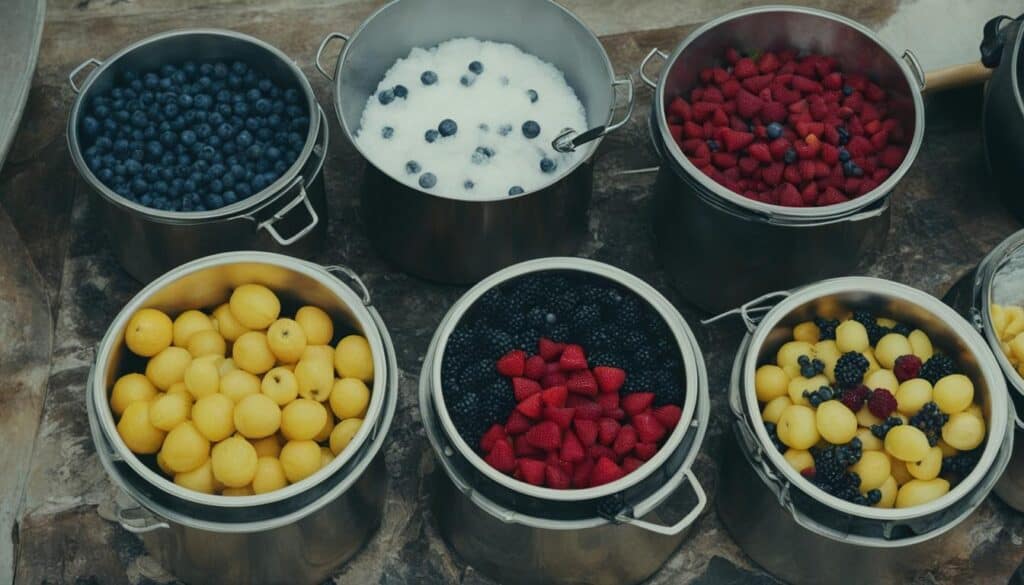
| Ingredients | Instructions |
|---|---|
|
|
Preserving with Pectin-Added Jam
Pectin-added jam is a popular method of preserving fruits, especially those with lower natural pectin content. By using powdered or liquid pectin, the fruit jam making process becomes more efficient and reliable, resulting in a consistent set.
Following the instructions provided with the pectin product is essential to achieve the desired results. This method allows for greater flexibility in fruit choices and flavors, making it a preferred option for many home cooks.
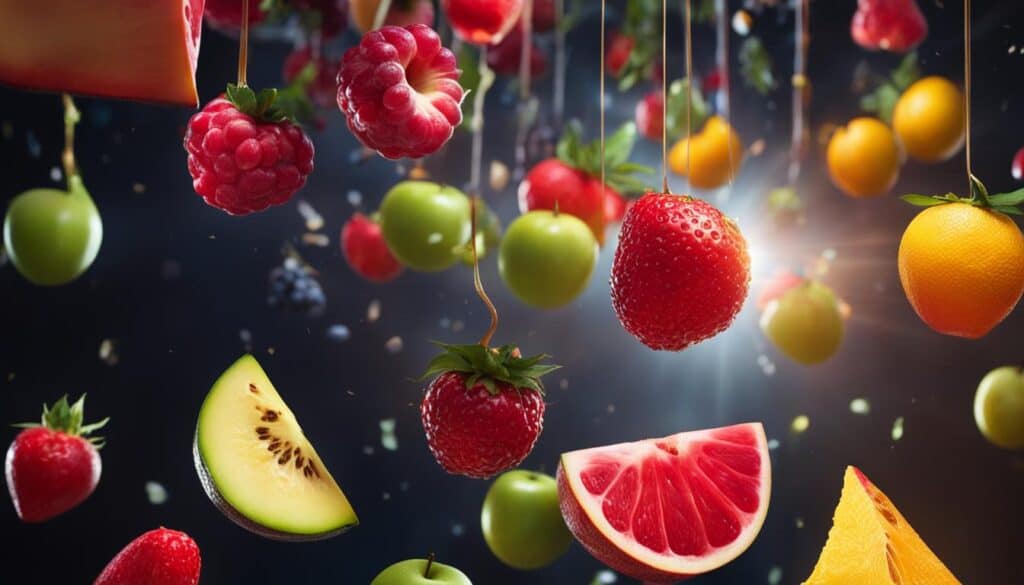
Canning Jams for Long-Term Storage
When it comes to fruit preservation methods, canning jams is a tried and true technique for ensuring long-term storage and savoring your favorite fruit flavors throughout the year. This traditional method involves filling sterilized jars with the cooked jam mixture and heat processing them in a boiling water bath canner to ensure food safety and seal the jars.
To successfully can jams, it’s important to follow the recommended procedure based on jar size and elevation. This ensures that the jams are properly heated, which destroys bacteria, yeast, and molds that could cause spoilage. By preserving the jams in sealed jars, they can be stored for an extended period without compromising their quality and taste.
The canning process not only allows you to enjoy the vibrant flavors of fresh fruits beyond their peak season but also provides the satisfaction of creating your own homemade preserves. With a pantry stocked with canned jams, you can elevate your breakfast toast, enhance your desserts, or even give them as thoughtful homemade gifts to loved ones.
A table below showcases the step-by-step process for canning jams:
| Step | Description |
|---|---|
| 1 | Prepare the fruit and ingredients. Wash and chop the fruits, measure the sugar and other flavor additions. |
| 2 | Cook the fruit. Simmer the fruit mixture until it reaches the desired consistency. |
| 3 | Sterilize the jars. Wash the jars and lids in hot soapy water or run them through the dishwasher. |
| 4 | Fill the jars. Ladle the hot jam into the sterilized jars, leaving a 1/4-inch headspace. |
| 5 | Process the jars. Place the filled jars in a boiling water bath canner and ensure they are fully submerged. Process for the recommended time based on your altitude. |
| 6 | Remove and cool. Carefully remove the jars from the canner and let them cool on a towel or wire rack. Listen for the satisfying “pop” as the jars seal. |
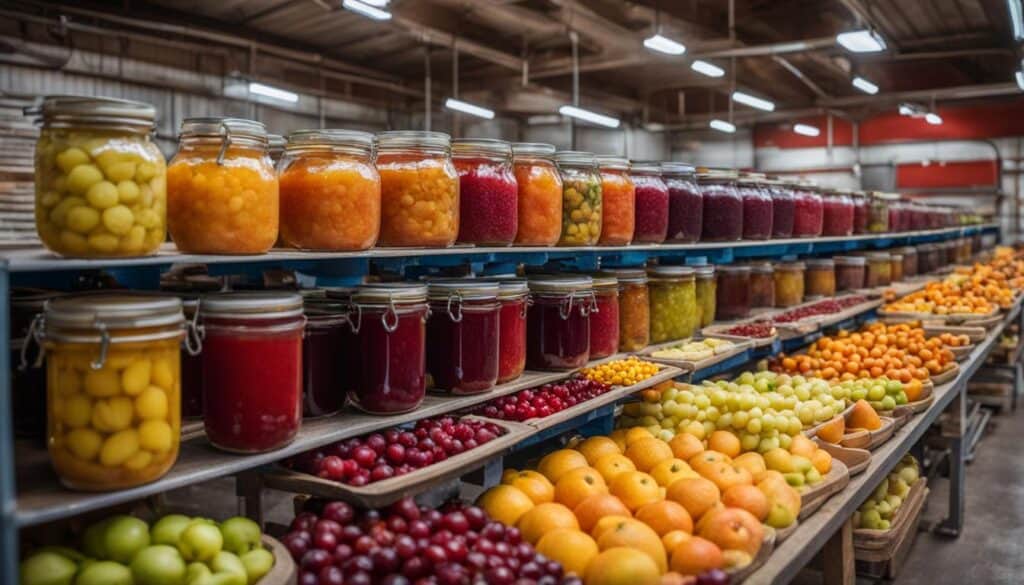
In addition to providing the convenience of long-lasting fruit preserves, canning jams is an opportunity to savor the fruits of your labor and share the joy of homemade goodness with family and friends. So gather your favorite fruits, prepare your canning equipment, and embark on a delicious journey of preserving and enjoying the flavors of the season.
Making Freezer Jam
Freezer jam offers a convenient and fuss-free way to preserve the flavors of your favorite fruits without the need for traditional canning methods. Made with fresh or frozen fruit, sugar, and pectin, freezer jam retains the natural freshness and vibrant colors of the fruits used.
The process of making freezer jam is simple and straightforward. Here’s a step-by-step guide to creating your own delicious freezer jam:
- Prepare the fruit: Begin by washing, peeling, and slicing the fruit as needed. Remove any seeds, pits, or tough cores. It’s best to use ripe, juicy fruits for maximum flavor.
- Mix the ingredients: In a large bowl, combine the prepared fruit with sugar and pectin, following the measurements specified in your chosen recipe. The sugar helps to sweeten the jam and preserve its freshness, while the pectin acts as a natural thickening agent.
- Let the mixture rest: Allow the fruit mixture to sit for a few minutes, giving the pectin time to activate and create a gel-like consistency. Stir the mixture occasionally to ensure the sugar is fully dissolved.
- Fill containers: Transfer the jam into clean freezer containers or canning jars, leaving some headspace at the top to allow for expansion during freezing. Seal the containers tightly.
- Set in the freezer: Place the filled containers in the freezer and let the jam set for the recommended time, typically a few hours or overnight. Freezing preserves the jam without altering its taste or texture.
- Thaw and enjoy: When you’re ready to enjoy your homemade freezer jam, remove the desired amount from the freezer and thaw it in the refrigerator. Once thawed, it can be used as a spread on toast, pancakes, or incorporated into various recipes.
Creating freezer jam is a quick and easy option for those who don’t want to go through the additional steps of traditional canning. It allows you to savor the natural flavors of seasonal fruits throughout the year, ensuring a taste of summer even in the colder months.
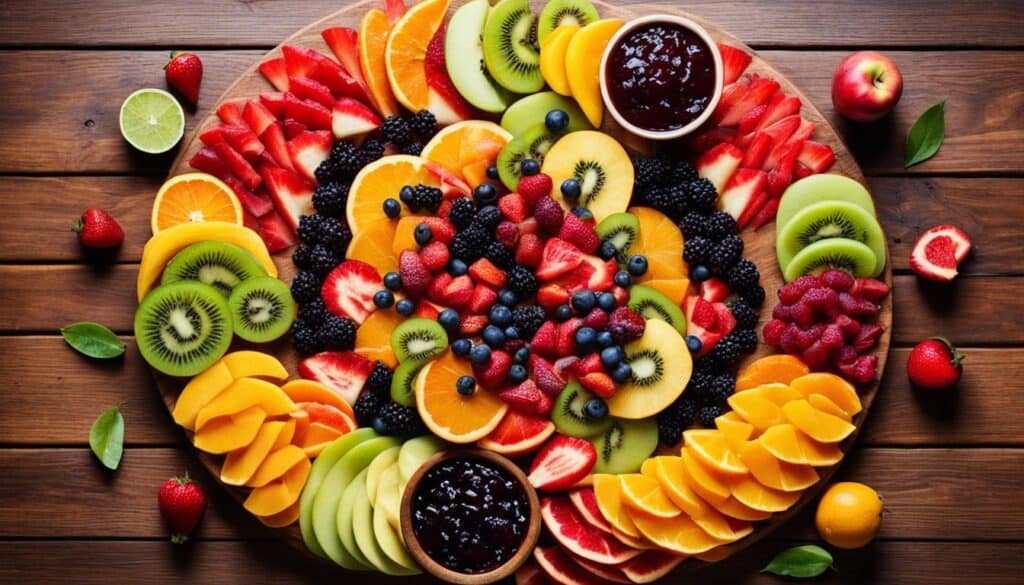
Frozen vs. Fresh: Which is Better?
When making freezer jam, it’s common to wonder whether it’s better to use fresh or frozen fruit. Both options have their advantages:
“Fresh fruit provides the peak flavors of the season, while frozen fruit offers convenience and availability year-round.”
For those fortunate enough to have access to fresh, ripe fruit, it’s an excellent choice for freezer jam. Fresh fruit provides the vibrant flavors and juicy textures that perfectly complement the homemade jam. However, if fresh fruit isn’t readily available or in season, utilizing frozen fruit is a convenient alternative. Frozen fruit is typically harvested at its peak and quickly frozen, preserving its taste and nutritional value.
| Frozen Fruit | Fresh Fruit |
|---|---|
| Convenience and year-round availability | Vibrant flavors and textures |
| Harvested at peak ripeness | Access to seasonal fruits |
| Longer shelf life | Immediate use after harvesting |
Whether you choose to use frozen or fresh fruit, freezer jam provides a delicious way to enjoy the taste of summer any time of the year.
The Importance of Sugar in Jam-Making
When it comes to making delicious jams from fruits, sugar plays a vital role that goes beyond just adding sweetness. Did you know that sugar acts as a natural preservative, helping to extend the shelf life of your homemade jams? It does this by creating an unfavorable environment for bacteria and other microorganisms, ensuring that your jams stay fresh and flavorful for longer.
But that’s not all – sugar also contributes to the texture and consistency of your jams. The combined effect of sugar and fruit juices, along with natural pectin, helps to thicken the mixture and create that beautiful, spreadable gel-like consistency we all love. Without the right amount of sugar, your jams may end up too runny or have difficulty setting properly.
Moreover, sugar enhances the flavor development in your jams. It helps to bring out the natural sweetness of the fruits and creates a balanced taste profile. The chemical reactions between sugar, fruit juices, and pectin during the cooking process release wonderful flavor compounds, resulting in a delightful sensory experience.
| BENEFITS OF MAKING JAMS FROM FRUITS |
|---|
| – Flavor preservation: Making jams from fruits allows you to capture the peak flavors of seasonal fruits and enjoy them throughout the year. |
| – Creative satisfaction: Jam-making provides a creative outlet, allowing you to experiment with different fruit combinations, flavors, and even spices or herbs. |
| – Healthier alternative: By making your own jams, you have control over the ingredients, reducing the amount of added sugars and avoiding unnecessary additives. |
| – Cost-effective: Making jams at home can be more affordable than buying commercially-made ones, especially when using surplus or discounted fruits. |
| – Personalized gifts: Homemade jams make thoughtful and heartfelt gifts for friends and loved ones, showcasing your culinary skills and thoughtfulness. |
“The right amount of sugar not only preserves the flavors but also enhances the texture, flavor, and overall quality of your homemade jams.”
While it is important to enjoy jams in moderation due to their sugar content, the overall benefits of making jams from fruits make them a delightful addition to any pantry. So, embrace the magic of sugar and indulge in the joy of creating your own homemade jams that burst with flavor and bring a touch of sweetness to your everyday meals.
The Science Behind Jam Texture
When it comes to achieving the perfect texture in homemade jams, there’s a fascinating science at play. Understanding the factors that contribute to texture can help you create delicious spreads with the ideal consistency.
Sugar, a key ingredient in jam-making, serves more than just a sweet purpose. It plays a crucial role in binding water molecules, reducing their availability for microbial growth. This helps preserve the jam and extend its shelf life.
Gel formation is another essential aspect of jam texture. Pectin, a natural thickening agent found in fruits, interacts with sugar and acid to create a gel-like structure. The right balance of these three elements—sugar, acid, and pectin—ensures that the jam sets properly.
The cooking and cooling techniques also contribute to achieving the desired texture. By cooking the fruit to release pectin, you promote gel formation. Proper cooling allows the pectin network to set, giving the jam its characteristic texture.
The texture of homemade jams can vary depending on these factors. Jams with a higher sugar content and longer cooking times tend to have a firmer texture, while those with less sugar and shorter cooking times may be softer and spreadable.
Table: Factors Affecting Jam Texture
| Factor | Texture Effect |
|---|---|
| Sugar Content | Determines the firmness of the jam |
| Cooking Time | Affects the thickness and consistency of the jam |
| Pectin Levels | Contributes to the gel formation and overall texture |
| Cooling Process | Allows the pectin to set and solidify the jam |
By understanding the science behind jam texture, you can consistently create jams that are a pleasure to spread and savor. Experimenting with different combinations of fruits, sugars, and cooking techniques allows you to tailor the texture to your preferences, whether you prefer a firm jelly or a soft, spoonable delight.
So, embrace the science, grab your apron, and embark on a journey to create homemade jams with the perfect texture that will delight your taste buds and elevate your culinary creations.
The Joy of Homemade Jams
Making homemade jams provides a sense of joy and creativity in the kitchen. It allows me to connect with the seasons, embracing the abundance of fresh fruits and turning them into delightful spreads.
I love experimenting with different fruit combinations and adding unique flavor elements like spices or herbs. This personal touch adds an extra level of satisfaction to each jar of homemade fruit jam.
There’s something magical about the process of making jams from fruits. From selecting the ripest fruits to watching them transform into a rich, flavorful spread, each step is filled with anticipation and excitement.
And it’s not just about the end product. The act of making homemade jams allows me to preserve the flavors of the season and enjoy them throughout the year. It’s like capturing a moment in time and savoring it whenever I spread a spoonful of homemade jam on my toast or drizzle it over my favorite desserts.
“Homemade jams are a labor of love, a way to express our creativity and passion for food. They bring joy to my kitchen and to the people I share them with.”
Whether it’s the satisfaction of creating something delicious or the joy of seeing loved ones enjoy the fruits of my labor, making homemade jams brings a special kind of happiness. It’s a reminder of the simple pleasures in life and the beauty of creating something from scratch.
So, next time you have a surplus of fresh fruits, I encourage you to embark on your own jam-making journey. Experience the joy of turning nature’s bounty into jars of homemade goodness, and savor the sweet taste of summer all year round.
Conclusion
Jams are more than just a sweet spread; they represent a culinary tradition that spans centuries. Making jams from fruits not only preserves the flavors of our favorite fruits but also provides a creative outlet and a connection to the seasons. The delicate balance of ingredients and the science behind jam-making ensure the perfect texture and flavor. From traditional canning methods to modern freezer jam alternatives, there are numerous ways to enjoy the process and the end result of homemade fruit jams. So, embrace the joy of jam-making and savor the sweet taste of homemade goodness.
FAQ
Why do we make jams from fruits?
Making jams from fruits allows us to preserve the flavors of seasonal fruits and enjoy them throughout the year. It also provides a creative outlet and a sense of satisfaction in the kitchen.
What are the benefits of making jams from fruits at home?
Homemade fruit jams offer the opportunity to customize flavors, create unique combinations, and experiment with spices or herbs. They also allow us to control the ingredients and sugar content, ensuring a healthier option compared to store-bought jams.
What is the history of jam-making?
The art of jam-making dates back centuries, with different fruit preservation methods evolving over time. From using honey in the early days to the accessibility of sugar in the 19th century, there are now numerous fruit jam recipes and techniques available.
How do ingredients play a role in jam-making?
The choice of ingredients determines the flavor and texture of the final jam. Fruits with high pectin content, such as apples and quinces, provide a natural thickening agent, while sugar acts as a preservative and helps with gel formation. Different fruit combinations and flavor additions result in a variety of delicious fruit jam flavors.
What is the science behind jam-making?
Pectin, the essential component in jams, forms a gel network that traps the sugary liquid and cradles the suspended fruit pieces. The addition of acid helps the pectin bond and form a strong gel. The high sugar content acts as a preservative, inhibiting the growth of microorganisms.
What is the recipe for perfect jam?
Most jam recipes recommend a 1:1 ratio of fruit to sugar, although this can be adjusted based on personal preference. The fruit should be cooked until tender, but not overly so, to maintain texture. Careful timing is crucial for achieving the desired consistency.
What is pectin-added jam?
Pectin-added jam is a popular method of preserving fruits that have lower natural pectin content. By using powdered or liquid pectin, the jam-making process becomes more efficient and reliable, resulting in a consistent set.
How do I can jams for long-term storage?
Canning jams involves filling sterilized jars with the cooked jam mixture and heat processing them in a boiling water bath canner. This process seals the jars and destroys any bacteria, yeast, or molds that could cause spoilage.
What is freezer jam?
Freezer jam is an alternative to traditional canning methods. It involves using fresh or frozen fruit, sugar, and pectin to create a jam that can be stored in the freezer. Freezer jam does not require cooking the fruit, preserving its fresh flavor and vibrant color.
What is the importance of sugar in jam-making?
Sugar acts as a preservative, helps thicken the jam, enhances flavor development, and promotes gel formation through its chemical reactions with fruit juices and pectin. While it is important to consume jams in moderation due to their sugar content, the overall benefits of making jams from fruits make them a delightful addition to any pantry.
What is the science behind jam texture?
Sugar binds water molecules, reducing their availability for microbial growth and adding to the jam’s preservation properties. Proper gel formation relies on the molecular structure of pectin and its interaction with sugar and acid. The right balance of sugar and acid, along with precise cooking and cooling techniques, ensures the desired texture of the jam.
What is the joy of homemade jams?
Making homemade jams provides a sense of joy and creativity in the kitchen. It allows us to connect with the seasons, create personalized flavors, and preserve the flavors of fresh fruits for enjoyment throughout the year.





Leave a Reply